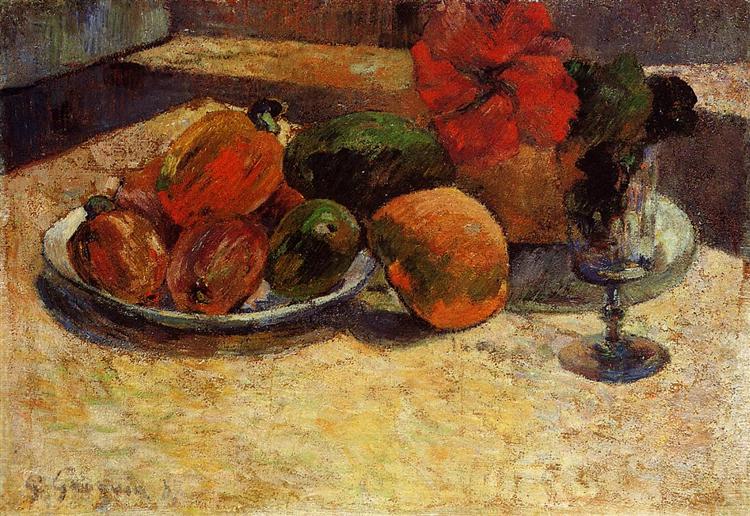Description
Paul Gauguin's Still Life with Mangos and Hibiscus, painted in 1887, is a fascinating manifestation of the post-impressionist style that the artist began to develop in the years before his departure for Polynesia. This still life, although seemingly simple in subject matter, reveals a visual and symbolic depth that is characteristic of Gauguin's innovative approach to painting.
Looking at the composition, the work displays a delicate balance between colour and form. Gauguin uses a vibrant palette in which yellows, greens and reds intertwine, creating a visual dialogue that captivates the viewer. The mangoes, depicted in an almost sensual way, seem to glow with a luminosity of their own, while the hibiscus flowers add a touch of exoticism to the whole. The way the artist groups the elements suggests a search for harmony, countering the fragmentation of space through the strategic placement of the fruits and flowers. This compositional principle becomes an intriguing contrast to the sharper, more geometric shapes in the background, making the objects in the foreground stand out with an almost palpable magnetism.
Gauguin delves into symbolism through his use of color. Each hue seems to convey not only an aesthetic feeling, but also an emotional charge. The vibrant yellow of the mangoes can be associated with warmth and fertility, while the deep reds of the hibiscus flowers evoke passion and life. Through this chromatic choice, Gauguin manages to create a work that is not only visually appealing, but also invites the viewer to reflect on the meaning and life behind these natural elements.
In this painting, there are no human figures to direct our attention, which is a distinctive feature of Gauguin's style. By eliminating figures, the artist is free to explore the essence of colors and shapes in their purest state. This choice reinforces the idea that nature, in itself, possesses enough beauty and meaning to be the central theme of art. This principle is also consistent with the master's evolution towards an art that seeks to translate emotions through the representation of nature and the use of color.
Part of his output from the 1880s, Still Life with Mangos and Hibiscus is set in a context where Gauguin began to distance himself from Impressionism and to experiment with more symbolic and decorative aspects of painting. In this work, one senses a premonition of the turn towards synthesis and the use of applied colour in later works in his career, especially in his depictions of Tahiti. Through his approach, Gauguin anticipates the move towards an art that challenges conventions, which would eventually influence later movements in modern art.
In conclusion, "Still Life with Mangos and Hibiscus" is more than just an arrangement of fruit and flowers; it is a compendium of emotions, colors and symbolism. The work bears witness to Gauguin's artistic evolution and his ability to transform the everyday into a space for emotional reflection. Thus, the painting consolidates itself as an essential piece not only in the artist's career, but also in the history of art, as it foreshadows a path that would take painting away from mere representation and towards a deeper search for truth through color and form.
KUADROS ©, a famous painting on your wall.
Hand-made oil painting reproductions, with the quality of professional artists and the distinctive seal of KUADROS ©.
Painting reproduction service with satisfaction guarantee. If you are not completely satisfied with the replica of your painting, we will refund 100% of your money.

